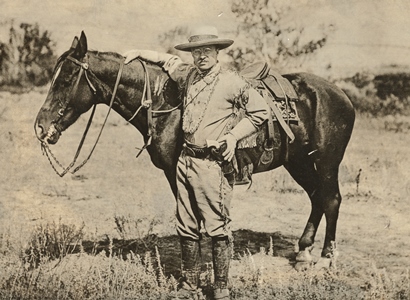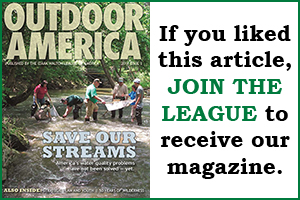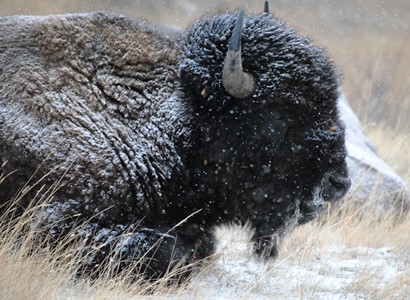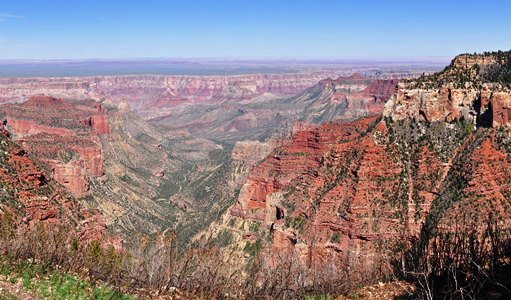In the fall of 1883, a westbound train stopped at the small Dakota Territory village of Little Missouri and an easterner with a new, hand-tailored, leather hunting suit and small, round glasses stepped down onto the wooden platform. Carrying his rifle in the crook of his arm, the stranger marched across the open Badlands toward a small huddle of dusty and dilapidated buildings not far from the station.
Along his walk to town, the stranger frequently stopped — sometimes marveling at the pointed rock formations that rose up from the desolate plains, other times bending down to examine some unusual plant that was powdered with prairie dust from passing locomotives. By the time the steam engine had rolled out of sight, the short, well-dressed eastern “dude” had reached the small cluster of saloons and sundry stores and brothels. He entered the closest saloon and, pushing his way through the crowd of range-weary cattlemen, introduced himself to the proprietor as Theodore Roosevelt, a Harvard graduate and the youngest member of the New York state assembly, and said that he had come to the Badlands to find a bison.
Roosevelt’s lofty stature on the east coast did very little to endear him to the cowboys of the Dakota Territories, men who had spent years fighting the bitter cold winters and flash floods, their faces reddened by the prairie winds and sun. To them, this Roosevelt was an alien, a member of another race and culture of highbred easterners who, a few at a time, came west to the Dakota Territory only to be killed or overwhelmed by life on the plains. For every wagon train that came to the Territory there were almost that many heading back east, and some of their passengers were making the return trip in a coffin.
Leading a “Strenuous Life”
Since the earliest days of his childhood, Theodore Roosevelt had been overlooked and dismissed. He was a small child with bad eyes and terrible asthma. At night, his breathing was so labored that his father would have to place him in the family carriage and rush him through the streets of New York so that the cool night air would settle his breathing. He’d been picked on at school, a small, spectacled boy who spoke with the formality of wealth and privilege.
Almost since those very early days of his youth, Roosevelt had been fighting back against his detractors. He learned to box and was on the team at Harvard, and he spent a great deal of his time in the gymnasium. The asthma episodes ceased, and the bullies learned quickly that young Teddy Roosevelt might look small, but he was incredibly strong and fast.
Roosevelt rallied from early political defeat to become a member of the New York state assembly at age 23. During those days, many members of the state assembly kept clubs and canes close at hand to defend themselves during particularly raucous meetings. Roosevelt spent much of his time attacking what he referred to as the “wealthy criminal class” that placed profits above the lives of workers. During this period, there was hardly an assembly meeting when Teddy’s shrill voice wasn’t heard shouting at the members with his characteristic fist-pounding fury.
Into the Badlands
During the summer of 1883, as Roosevelt was busy sorting out corruption and trying to establish a suitable standard of living for New York laborers, retired Naval commander H.H. Gorringe asked Roosevelt if he’d be interested in traveling to the Dakota Territory for a mixed bag hunt that was to include deer, elk, antelope, and bison. Roosevelt was even more passionate about natural history than he was about politics. In his youth, several members of the family’s cleaning staff resigned when young Teddy brought home “specimens” of dead animals from the field, most notably a seal skull that he counted among his most prized possessions and kept in his personal museum on the top floor of his family home. For Roosevelt, the opportunity to hunt in the Dakota Badlands was a dream, and in the fall of that year he took a hiatus to travel west with Gorringe.
 Comprising steep canyons and spires carved by millions of years of exposure to the eroding forces of wind and water, the Badlands are one of the most hostile landscapes in all of North America. The vast grassy plains of the Dakotas are interrupted by canyons, hills, and hoodoos (or tent rocks) — all colored in various shades of purple, brown, tan, and black based on their strata formations. The region was the last stronghold of the Oglala Sioux nation, and the entire area was very important for the region’s first nations because it was home to a large number of bison. And just as it was for generations of Oglala and other American Indian nations, it was the pursuit of the magnificent bison that drew Roosevelt to the Badlands.
Comprising steep canyons and spires carved by millions of years of exposure to the eroding forces of wind and water, the Badlands are one of the most hostile landscapes in all of North America. The vast grassy plains of the Dakotas are interrupted by canyons, hills, and hoodoos (or tent rocks) — all colored in various shades of purple, brown, tan, and black based on their strata formations. The region was the last stronghold of the Oglala Sioux nation, and the entire area was very important for the region’s first nations because it was home to a large number of bison. And just as it was for generations of Oglala and other American Indian nations, it was the pursuit of the magnificent bison that drew Roosevelt to the Badlands.
As it turned out, Gorringe was unable to make the trip, but Roosevelt traveled alone to the Badlands. He had some trouble in Little Missouri — none of the ranchers were willing to invest time dragging an eastern hunter out into the wilderness in search of game. Roosevelt was persistent, though, speaking to several of the ranchers in the saloon until he found one man named Joe Ferris who was willing to act as a guide for Roosevelt’s bison hunt.
For Roosevelt, the bison was the most iconic of all western trophies, and he’d read about the vast herds that stretched from one horizon to the next. During the westward expansion, bison stretched from the plains of Indiana all the way to the Rockies in herds that were estimated at 30 million animals, the largest group of mammals found anywhere in the world. With construction on his Sagamore Hill home on Long Island underway, Roosevelt felt that a bison head would be the perfect centerpiece for his trophy room.
The Decline of Western Wildlife
Roosevelt was shocked by the lack of game he encountered in the Badlands. Rapid westward expansion and the rise in market hunting had severely depleted the bison herds. The area had once been the hunting grounds of the Lakota Nation, but settlers had indiscriminately killed great numbers of bison and turned the prairie into pasture for cattle. The thousands of bison that had once roamed the Badlands were reduced to a few hundred animals that remained in the most isolated pockets of wilderness. The vast plains were dusty and barren after the cattle herds had overgrazed the fragile prairie grass. Still, Roosevelt was resolute, and with Ferris as his guide, he set out on horseback to find his trophy.
 Joe Ferris was more than willing to take the young easterner’s money and to act as a guide, although he doubted that Roosevelt would last long enough in the Badlands to search out the bison herds. From Little Missouri, the pair rode deep into the Badlands, past the wasteland of dry prairie overrun with domestic cattle into the steep, dry ravines and rocky cliffs far beyond the settlements.
Joe Ferris was more than willing to take the young easterner’s money and to act as a guide, although he doubted that Roosevelt would last long enough in the Badlands to search out the bison herds. From Little Missouri, the pair rode deep into the Badlands, past the wasteland of dry prairie overrun with domestic cattle into the steep, dry ravines and rocky cliffs far beyond the settlements.
Roosevelt was alternatively enthralled by the rugged landscape and infuriated by the waste he witnessed at the hands of ranchers. The landscape that had once been home to great herds of bison and antelope was now a barren graveyard littered with dried bones and bleached skulls of animals shot and wasted to make room for domestic cattle herds.
Deep in the most remote pockets of the Badlands, a few isolated herds of antelope, deer, and bison remained intact. In his journal, Roosevelt reflected on the natural beauty of the landscape — vast seas of sagebrush and grass interrupted by steep canyons and white, rounded peaks. On at least four occasions Roosevelt stumbled upon rattlesnakes, one of which Roosevelt nearly crawled on top of as he stalked a herd of antelope in the backcountry. He and Ferris rode and camped for weeks, spending much of the day scouring the dry earth for bison tracks under the intense prairie sun. Ferris grew to admire the small New Yorker who proved time and again that he was more than capable of surviving in the Badlands and who hunted from daylight until dusk with the same unwavering dedication and appreciation for the rugged and beautiful landscape.
The Bull of His Dreams
 After several weeks in the Badlands, Roosevelt slipped down from his horse and studied the rounded print of a bison bull — the first they’d seen during the hunt. He pulled his rifle from the case and, leaving Ferris behind with the horses, Roosevelt started his stalk. The bison track was fresh, and Roosevelt stayed on the track as it wound through a series of cliffs and crested a ridge that led into a steep canyon. Pushing his rifle ahead, Roosevelt moved to the top of the ridge, pausing now and again to check for rattlesnakes as he worked his way to the mouth of the cliff. There, in a valley far below, he saw the hulking, dust-covered form of a single old bison bull making its way down the length of the canyon.
After several weeks in the Badlands, Roosevelt slipped down from his horse and studied the rounded print of a bison bull — the first they’d seen during the hunt. He pulled his rifle from the case and, leaving Ferris behind with the horses, Roosevelt started his stalk. The bison track was fresh, and Roosevelt stayed on the track as it wound through a series of cliffs and crested a ridge that led into a steep canyon. Pushing his rifle ahead, Roosevelt moved to the top of the ridge, pausing now and again to check for rattlesnakes as he worked his way to the mouth of the cliff. There, in a valley far below, he saw the hulking, dust-covered form of a single old bison bull making its way down the length of the canyon.
The bison was headed away from Roosevelt, so he knew he would have to work his way around the rough, rocky terrain to get into position for a shot. On hands and knees, he worked down the rim of the canyon, his rifle in hand, and watched the bull march steadily down the dusty riverbed ahead of him. Eventually, Roosevelt worked himself into a position where he was perpendicular to the old bull, and he eased his rifle into a resting position on the canyon rim. Wiping the dust from his spectacles, he lined the sights of his rifle on the bison’s shoulder. When the bull stopped, Roosevelt fired.
The bullet struck hard and the bull went down in a cloud of dust. Barely able to contain his own excitement, Roosevelt clambered down the steep canyon walls to the place where the bull lay outstretched in the sand. It was the first bison that he had seen at such close range. Soon Roosevelt and Ferris began the tremendous task of skinning and butchering the bison to take it back to Little Missouri, where the same dusty cowboys that had refused to act as Roosevelt’s guide marveled at the tremendous trophy that the eccentric eastern hunter had taken after weeks on the trail and a single well-placed shot. With his characteristic enthusiasm, Roosevelt sent a telegraph back to his wife in New York that simply read, “Bring you home the head of a great buffalo bull.”
A Lasting Impact
Despite the hardships of the hunt, Roosevelt held a deep appreciation for the Badlands. He also understood that, despite their once-great numbers, the bison herds in the area had nearly been driven to extinction. For Roosevelt, this served as a warning of what might happen elsewhere if conservation laws were not put in place to protect wildlife and essential habitat. That buffalo hunt inspired Roosevelt to move to the Badlands, where he later owned two ranches and worked to maintain a balance between the grazing needs of his own cattle and the requirements of native wildlife.

Much like the battles he fought for workers in New York, Roosevelt believed that for wildlife populations to remain intact for future generations, laws would have to be put into place that would guard against exploitation and overuse. During his time in the New York state assembly and as governor, and later as the U.S. vice president and president, Roosevelt became a champion of preserving habitat and the responsible use of wildlife resources. In 1903, Roosevelt established Pelican Island in Florida as a national bird refuge to protect shore birds from overutilization by the fashion industry. In 1905, he established the National Forest Service, and in 1906 helped pass the Antiquities Act, which gave the president sole authority to declare and protect national monuments. He established or enlarged 150 national forests and more than 50 federal bird reservations (which became national wildlife refuges). Altogether, Roosevelt put more than 230 million acres of land under federal protection.
The United States offers unprecedented access to public lands, something that Roosevelt envisioned more than a century ago. Today hikers, campers, hunters, and anglers have access to hundreds of millions of acres of land. Although we sometimes take this incredible legacy of public lands for granted, it is important to remember that Roosevelt and others fought hard to promote the idea of protecting public lands to enrich the lives of the American people.
He also helped cultivate national awareness regarding the need to preserve the American wilderness and protect wildlife, which eventually promoted a national conservation model under which sportsmen help provide the funding for wildlife and habitat conservation through taxes, licenses, and fees.
As a hunter, Roosevelt would have been proud of this conservation model. His vision of a prosperous nation that understands the value of its wild resources has come to pass, and we sportsmen must act as the torch-bearers for Roosevelt’s dream of protecting, promoting, and conserving America’s abundant wildlife and natural resources.